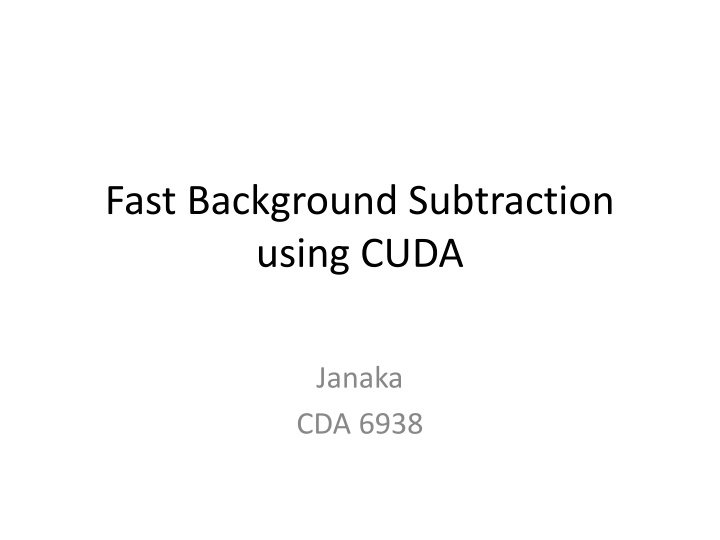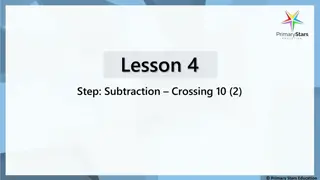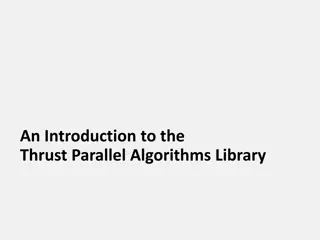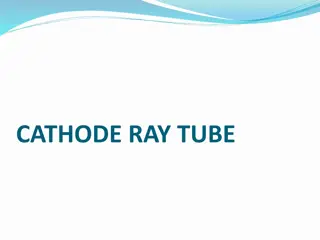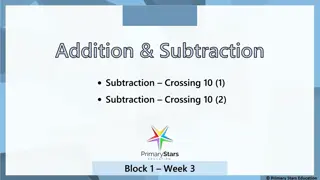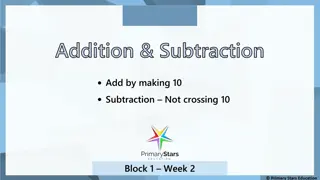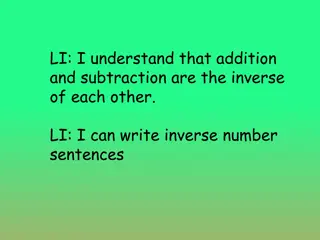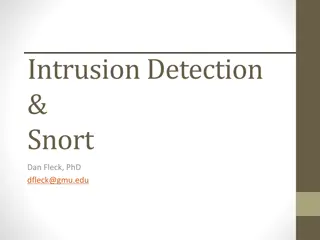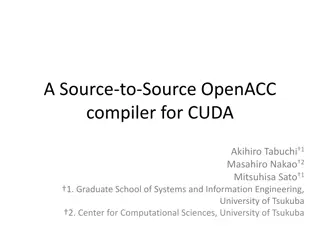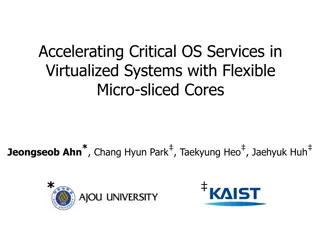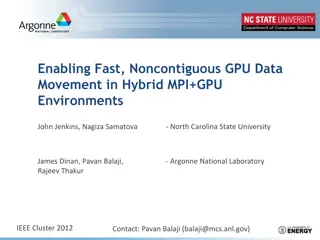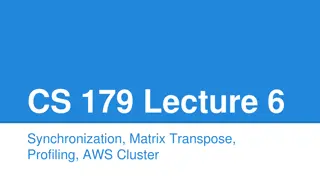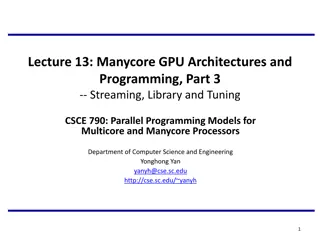Fast Background Subtraction Using CUDA: Accelerating Foreground Detection
Background subtraction is a vital step in computer vision, enabling the identification of foreground pixels in dynamic scenes. Traditional methods face challenges due to illumination changes, camera issues, and background object variations. Current approaches like Gaussian Mixture Models (GMM) offer real-time solutions by classifying pixels as background or foreground based on evolving background models. Enhanced GMM techniques provide faster and more accurate background subtraction, enhancing the performance of vision algorithms in tasks such as vehicle speed computation from video.
Uploaded on Feb 15, 2025 | 3 Views
Download Presentation

Please find below an Image/Link to download the presentation.
The content on the website is provided AS IS for your information and personal use only. It may not be sold, licensed, or shared on other websites without obtaining consent from the author.If you encounter any issues during the download, it is possible that the publisher has removed the file from their server.
You are allowed to download the files provided on this website for personal or commercial use, subject to the condition that they are used lawfully. All files are the property of their respective owners.
The content on the website is provided AS IS for your information and personal use only. It may not be sold, licensed, or shared on other websites without obtaining consent from the author.
E N D
Presentation Transcript
Fast Background Subtraction using CUDA Janaka CDA 6938
What is Background Subtraction? Identify foreground pixels Preprocessing step for most vision algorithms
Applications Vehicle Speed Computation from Video
Why is it Hard? Na ve Method |framei background| > Threshold 1. Illumination Changes Gradual (evening to night) Sudden (overhead clouds) 2. Changes in the background geometry Parked cars (should become part of the background) 3. Camera related issues Camera oscillations (shaking) Grainy noise 4. Changes in background objects Tree branches Sea waves
Current Approaches Frame Difference | framei frame(i-1) |> Threshold Background as the running average Bi+ 1= * Fi+ (1 - ) * Bi Gaussian Mixture Models Kernel Density Estimators
Gaussian Mixture Models Each pixel modeled with a mixture of Gaussians Flexible to handle variations in the background
GMM Background Subtraction Two tasks performed real-time Learning the background model Classifying pixels as background or foreground Learning the background model The parameters of Gaussians Mean Variance and Weight Number of Gaussians per pixel Enhanced GMM is 20% faster than the original GMM* * Improved Adaptive Gaussian Mixture Model for Background Subtraction , Zoran Zivkovic, ICPR 2004
Classifying Pixels = value of a pixel at time t in RGB color space. Bayesian decision R if pixel is background (BG) or foreground (FG): Initially set p(FG) = p(BG), therefore if decide background = Background Model = Estimated model, based on the training set X
The GMM Model Choose a reasonable time period T and at time t we have For each new sample update the training data set Re-estimate Full scene model (BG + FG) GMM with M Gaussians where - estimates of the means - estimates of the variances - mixing weights non-negative and add up to one.
The Update Equations Given a new data sample update equations where, is set to 1 for the close Gaussian and 0 for others and is used to limit the influence of old data (learning rate). An on-line clustering algorithm. Discarding the Gaussians with small weights - approximate the background model : If the Gaussians are sorted to have descending weights : where cf is a measure of the maximum portion of data that can belong to FG without influencing the BG model
CPU/GPU Implementation Treat each pixel independently Use the Update Equations to change GMM parameters
How to Parallelize? Simple: One thread per pixel Each pixel has different # of Gaussians Divergence inside a warp
Preliminary Results Speedup: mere 1.5 X QVGA(320 x 240) Video Still useful since CPU is offloaded
Optimization Constant Memory Pinned (non pageable) Memory Memory Coalescing Structure of Arrays Vs Array of Structures Packing and Inflating Data 16x16 block size Asynchronous Execution Kernel Invocation Memory Transfer CUDA Streams
Memory Related Constant Memory Cached Used to store all the configuration parameters Pinned Memory Required for Asynchronous transfers Use CudaMallocHost rather than malloc Transfer BW for GeForce 8600M GT using bandwidthTest Pageable Pinned CPU to GPU 981 MB/s 2041 MB/s GPU to CPU 566 MB/s 549 MB/s
CUDA Memory Coalescing (recap)* A coordinated read by 16 threads (a half-warp) A contiguous region of global memory: 64 bytes - each thread reads a word: int, float, 128 bytes - each thread reads a double-word: int2, float2 256 bytes each thread reads a quad-word: int4, float4, Starting address must be a multiple of region size * Optimizing CUDA, Paulius Micikevicius
Memory Coalescing Compaction uses less registers Inflation for coalescing
Memory Coalescing SoA over AoS for coalescing
Asynchronous Invocation int cuda_update(CGMMImage2* pGMM, pUINT8 imagein, pUINT8 imageout) { //wait for the previous memory operations to finish cudaStreamSynchronize(pGMM->copyStream); //copy into and from pinned memory memcpy(pGMM->pinned_in, imagein, ....); memcpy(imageout, pGMM->pinned_out, ....); //make sure previous exec finished before next memory transfer cudaStreamSynchronize(pGMM->execStream); //swap pointers swap(&(pGMM->d_in1), &(pGMM->d_in2)); swap(&(pGMM->d_out1), &(pGMM->d_out2)); //copy the input image to device cudaMemcpyAsync(pGMM->d_in1, pGMM->pinned_in, ...., pGMM->copyStream); cudaMemcpyAsync(pGMM->pinned_out, pGMM->d_out2, ...., pGMM->copyStream); //call kernel backSubKernel<<<gridB, threadB, 0, pGMM->execS>>>(pGMM->d_in2, pGMM->d_out1, ...); } return 0;
Gain from Optimization Observe how the running time improved with each optimization technique Na ve Version (use constant memory)- 0.110 seconds Partial Asynchronous Version (use pinned memory) - 0.078 Memory coalescing (use SoA) - 0.059 More coalescing with inflation and compaction - 0.055 Complete Asynchronous - 0.053
Experiments - Speedup Final speedup 3.7 X on GeForce 8600M GT 3.8 3.7 3.6 Speedup 3.5 3.4 3.3 0 256 512 768 1024 1280 1536 1792 2048 2304 Video Resolution
Frame Rate 481 fps 256 x 256 video on 8600M GT HD Video Formats 720p (1280 x 720) 40 fps 1080p (1920 x 1080) 17.4 fps 600 500 GPU frame rate 400 CPU frame rate Frame Rate 300 200 100 0 0 256 512 768 1024 1280 1536 1792 2048 2304 Video Resolution
Foreground Fraction Generate video frames with varying numbers of random pixels GPU version is stable compared to CPU version 1.6 1.4 Time to process 100 frames (in seconds) 1.2 1 CPU 0.8 GPU 0.6 0.4 0.2 0 0 0.2 0.4 0.6 0.8 1 Fraction of Foreground Pixels
Matlab Interface (API) Interface for developers Initialize h = BackSubCUDA(frames{1}, 0, [0.01 5*5 1 0.5 gpu]); Add new frames for i=1:numImages output = BackSubCUDA(frames{i}, h); end; Destroy clearBackSubCUDA
Conclusions Advantages of the GPU version (recap) Speed Offloading CPU Stability Overcoming the Host/Device transfer overhead Need to understand optimization techniques
